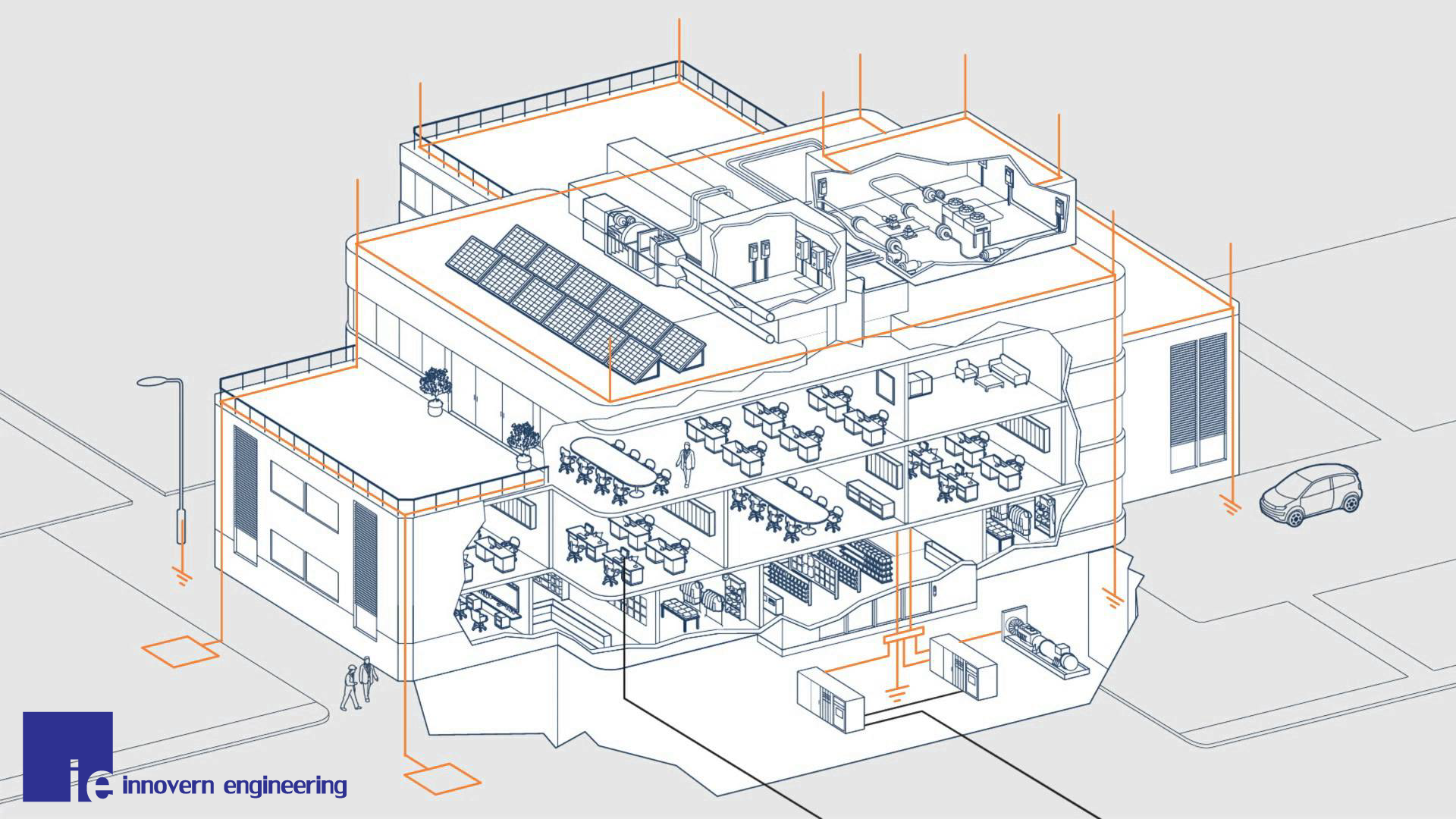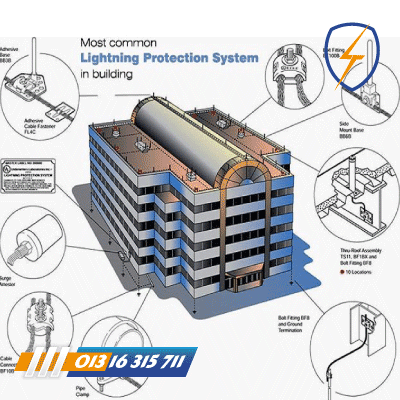Ensure The Lightning Safety.
How to ensure the lightning safety?
Lightning safety doesn’t mean that you install a lightning air terminal and make a path by conducting metal to the ground. Installation of Lightning Protection System (such as Air-terminal, conductors & ground) on structures only protect the direct lightning. Ensuring the complete lightning safety involves a combination of preparedness, protective measures, and educational awareness to minimize the risk of injury and damage caused by lightning. It requires a holistic approach that includes protecting people, buildings, and critical systems. Below is a comprehensive guide to achieving full lightning safety:
1. Develop a Lightning Safety Plan
- Risk Assessment: Conduct a lightning risk assessment for the area or building to determine the likelihood of lightning strikes. Identify high-risk activities (e.g., outdoor sports, work at elevated locations) and locations (open fields, isolated trees, tall structures). The follow BNBC, NFPA or IEC guideline for the lightning risk assessment.
- Emergency Procedures: Establish emergency procedures for outdoor activities, workplaces, and buildings, including when to take shelter and how to respond if a lightning strike occurs.
- Evacuation Protocols: Ensure that evacuation plans are in place and clearly communicated. Establish designated safe areas where people can gather during thunderstorms (e.g., indoor shelters, lightning-protected buildings).
2. Install Lightning Protection Systems
Lightning protection systems (LPS) provide critical protection for buildings, electrical infrastructure, and sensitive equipment.
- Conventional Lightning Protection System: Install a system that includes air terminals (lightning rods), down-conductors, and grounding electrodes to protect structures. Ensure compliance with relevant standards such as BNBC2020, IEC 62305, NFPA 780, or BS EN 62305.
- Early Streamer Emission (ESE) Systems: In certain cases, ESE systems can be used to extend the area of protection, particularly for larger structures like industrial buildings or stadiums.
- Grounding and Bonding: Properly ground and bond all electrical systems, metal objects, and equipment to ensure the safe dissipation of lightning currents into the earth.
- Surge Protection Devices (SPDs): Install SPDs at key points in the electrical system (e.g., at the main electrical panel, subpanels, and outlets) to protect electrical and electronic equipment from voltage surges caused by lightning.
- Faraday Cage or Shielding: In some applications, such as data centers or sensitive laboratories, use Faraday cages or metal shielding to prevent lightning from reaching critical areas.
3. Provide Personal Lightning Safety Guidelines
Educating individuals on lightning safety practices is crucial to ensuring personal safety, especially in outdoor environments.
- Follow the 30-30 Rule: When you see lightning, start counting until you hear thunder. If the time between lightning and thunder is 30 seconds or less, seek shelter immediately. Remain in shelter until 30 minutes after the last clap of thunder.
- Seek Shelter Indoors: The safest place during a thunderstorm is inside a well-constructed building with lightning protection or a hard-topped vehicle. Avoid small structures like sheds, tents, and pavilions, which do not offer adequate protection.
- Avoid Open Spaces: If you are outside and cannot find shelter, avoid open fields, hilltops, and isolated trees. Crouch low to the ground with as little of your body touching the ground as possible to minimize your exposure.
- Avoid Water and Metal Objects: Stay away from bodies of water (pools, lakes, rivers) and avoid contact with metal objects (fences, poles, machinery), which can conduct lightning.
- Stay Away from Windows: Indoors, avoid standing near windows, doors, and electrical appliances. Refrain from using wired devices such as corded phones or computers during a thunderstorm.
4. Implement Workplace Lightning Safety
Workplaces, especially those involving outdoor labor or tall structures, require specific lightning safety measures.
- Outdoor Workers: Establish safety protocols for workers in open fields, construction sites, or elevated positions. Workers should be trained to recognize thunderstorm signs and be provided with a safe shelter to retreat to when storms approach.
- Shut Down High-Risk Activities: For outdoor operations such as crane work, roofing, or construction, ensure that work is suspended at the first sign of lightning. Equipment that extends into the air, such as cranes or antennas, should be grounded or disconnected when possible.
- Safety in Hazardous Areas: For hazardous areas like chemical plants or explosive environments, additional lightning safety measures must be taken, including the use of specialized lightning protection systems and ensuring that the shutdown procedures are initiated during storms.
5. Protect Critical Systems and Equipment
Protecting electrical, electronic, and communication systems from lightning-induced surges is a key aspect of complete lightning safety.
- Backup Power and Redundancy: Install backup power systems (e.g., generators, uninterruptible power supplies) that are isolated from lightning exposure to ensure continued operation of critical systems during power outages caused by lightning.
- Communication Systems: Protect communication networks (e.g., radio towers, telephone lines) with surge protection and grounding systems to prevent lightning from causing damage to communication infrastructure.
- Data Backup: Regularly back up data and critical systems to ensure that valuable information is not lost due to lightning-induced surges or fires.
6. Ensure Compliance with Standards and Regulations
- Adhere to National and International Standards: Ensure that all lightning protection systems are installed and maintained in accordance with applicable standards (e.g., BNBC2020, NFPA 780, IEC 62305, UL 96A, BS EN 62305) and local building codes.
- Regular Inspections and Maintenance: Schedule regular inspections of the lightning protection system to ensure that all components are in good working condition. Periodically test grounding systems to verify their effectiveness.
- Certifications: Obtain certification for the lightning protection system from a qualified engineer or relevant authority to ensure it meets the necessary safety requirements.
7. Promote Public Education and Awareness
- Education Campaigns: Conduct public education campaigns to raise awareness of lightning safety, especially in regions prone to thunderstorms. Distribute safety guidelines for outdoor events, schools, parks, and other public spaces.
- Training Programs: Offer lightning safety training programs for first responders, facility managers, and key personnel to ensure they are prepared to manage lightning emergencies.
- Use of Technology: Promote the use of weather alert apps, weather radios, or lightning detection systems to provide real-time alerts to people in outdoor environments.
8. Respond to Lightning Emergencies
- First Aid for Lightning Strikes: Train individuals on how to administer first aid to people struck by lightning. Immediate actions such as performing CPR or using an automated external defibrillator (AED) can save lives.
- Emergency Preparedness: Ensure that emergency services and first responders are familiar with the building’s layout and lightning protection systems to respond effectively in the event of a lightning-related incident.
Conclusion
Complete lightning safety involves a multi-layered approach that includes physical protection systems, personal safety practices, workplace protocols, and ongoing education. By implementing comprehensive measures and staying informed about lightning safety best practices, you can greatly reduce the risks posed by lightning and protect both people and property from its harmful effects.





Leave a Reply